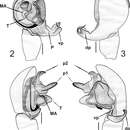en
names in breadcrumbs


The spider family Nesticidae includes 218 described species (Platnick 2013), 38 of which are known from North America north of Mexico (Paquin and Hedin 2005). In temperate regions, nesticids tend to occur near the surface in caves, or in cave-like (cool, moist, dark) habitats, although in the tropics and subtropics they may be more associated with leaf litter (Lehtinen and Saaristo 1980 and references therein). Most of the U.S. species are in the genus Nesticus. More than two dozen Nesticus species are known from the Appalachians, but just three species from the western U.S. Several Eidmannella species are Texas cave endemics, but Eidmannella pallida is widespread throughout the United States, Mexico, Central America, and the West Indies and now occurs on various Pacific Ocean islands, Spain, and elsewhere as well (Platnick 2013 lists this species as "cosmopolitan"). Gaucelmus augustinus is found in Florida and the adjacent Gulf states to Texas, throughout Mexico to Panama, and in the West Indies. Along with its native species, North America has an introduced and synanthropic nesticid, Nesticus cellulanus, which is native to Europe but is now found on the east coast of North America as far north as Québec. In addition to the already mentioned Eidmannella pallida and Nesticus cellulanus, other nesticids have also expanded beyond their native ranges via human activities. For example, Nesticella mogera is native to Asia but has been introduced to Fiji, Germany and Hawaii (Lehtinen & Saaristo 1980; Gertsch 1984; Kielhorn 2009 cited in Vink and Dupérré 2011) and the European Nesticus eremita has spread to new regions of Europe and has been collected in New Zealand (Vink and Dupérré 2011 and references therein).
Some nesticids exhibit traits associated with obligate cave-dwelling (e.g., lack of eyes, pale color, relatively long legs and large size). Surface-dwelling species occur in deep leaf litter, under stones in boulder fields, and in crevices of rocky cliffs near creeks and streams. Nesticids build webs similar to those of theridiids (their likely sister clade, with which they also share morphological similarities), with a tangled retreat suspended above sticky vertical lines, and typical single vertical threads that split near the end. The webs usually span small spaces in appropriate microhabitats. Nesticus egg sacs are carried by the female with their chelicerae or spinnerets, a behavior not seen in most theridiids (Bradley 2013). Reeves (2000) mapped the distribution of Nesticus barrowsi in the caves of Great Smoky Mountains National Park and Hedin and Dellinger (2005) and Cokendolpher and Reddell (2001) reviewed the precarious population status of, respectively, several Nesticus species in the Appalachians and Eidmannella species in Texas caves.
Gertsch (1984) originally described most of the nesticids known from North America north of Mexico (five new Eidmannella and 23 new Nesticus). A handful of additional nesticids from this region have been described subsequently (Coyle and McGarity 1991; Cokendolpher and Reddell 2001; Hedin and Dellinger 2005). Hedin (1997a,b) analyzed speciation patterns in Nesticus in the southern Appalachians and Snowman et al. (2010) investigated the phylogeography of the cave-dwelling Nesticus barri on the southern Cumberland Plateau of southcentral Tennessee and northeastern Alabama. Zhang and Li (2013) investigated the diversification of Nesticella in China's Yunnan–Guizhou Plateau.
(Paquin and Hedin 2005 and references therein)